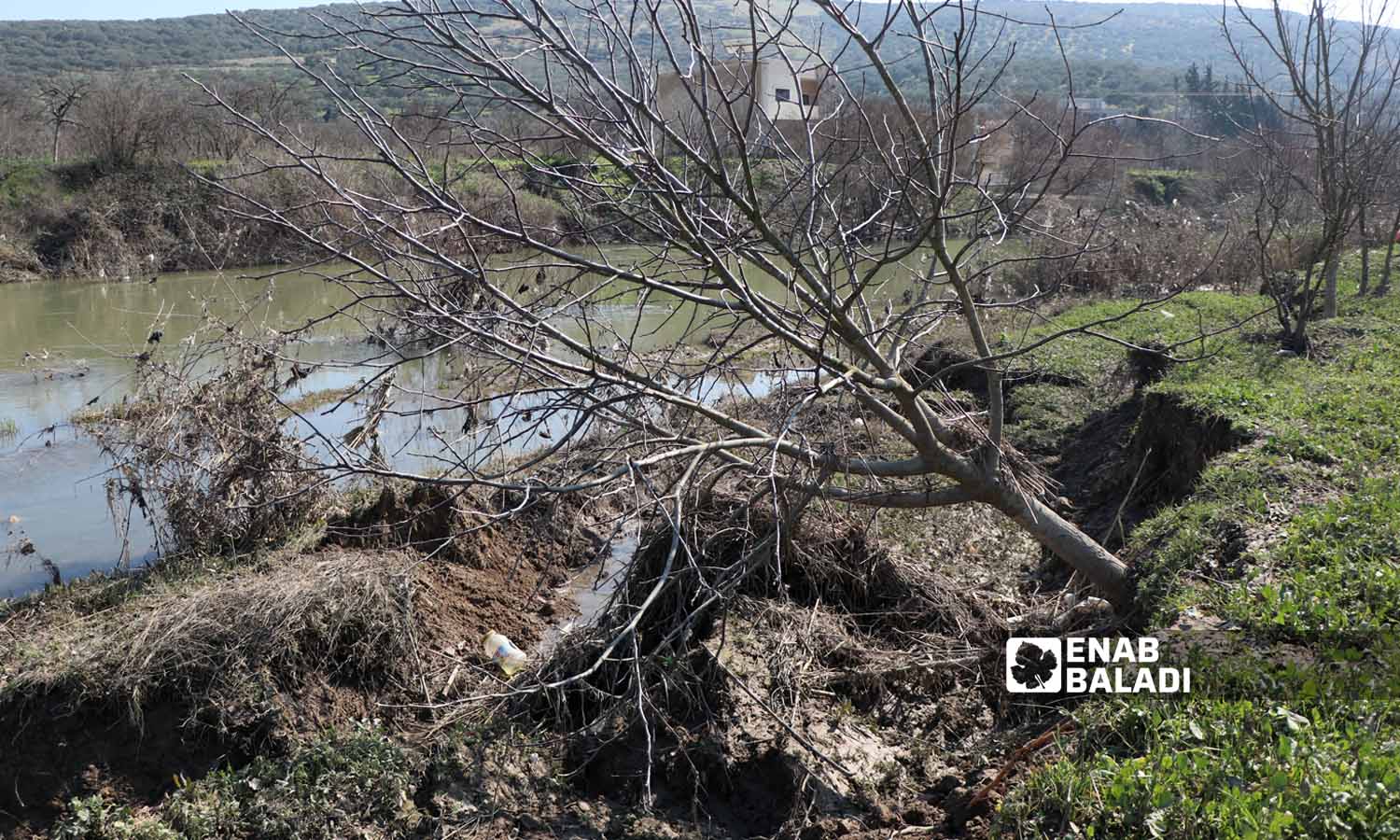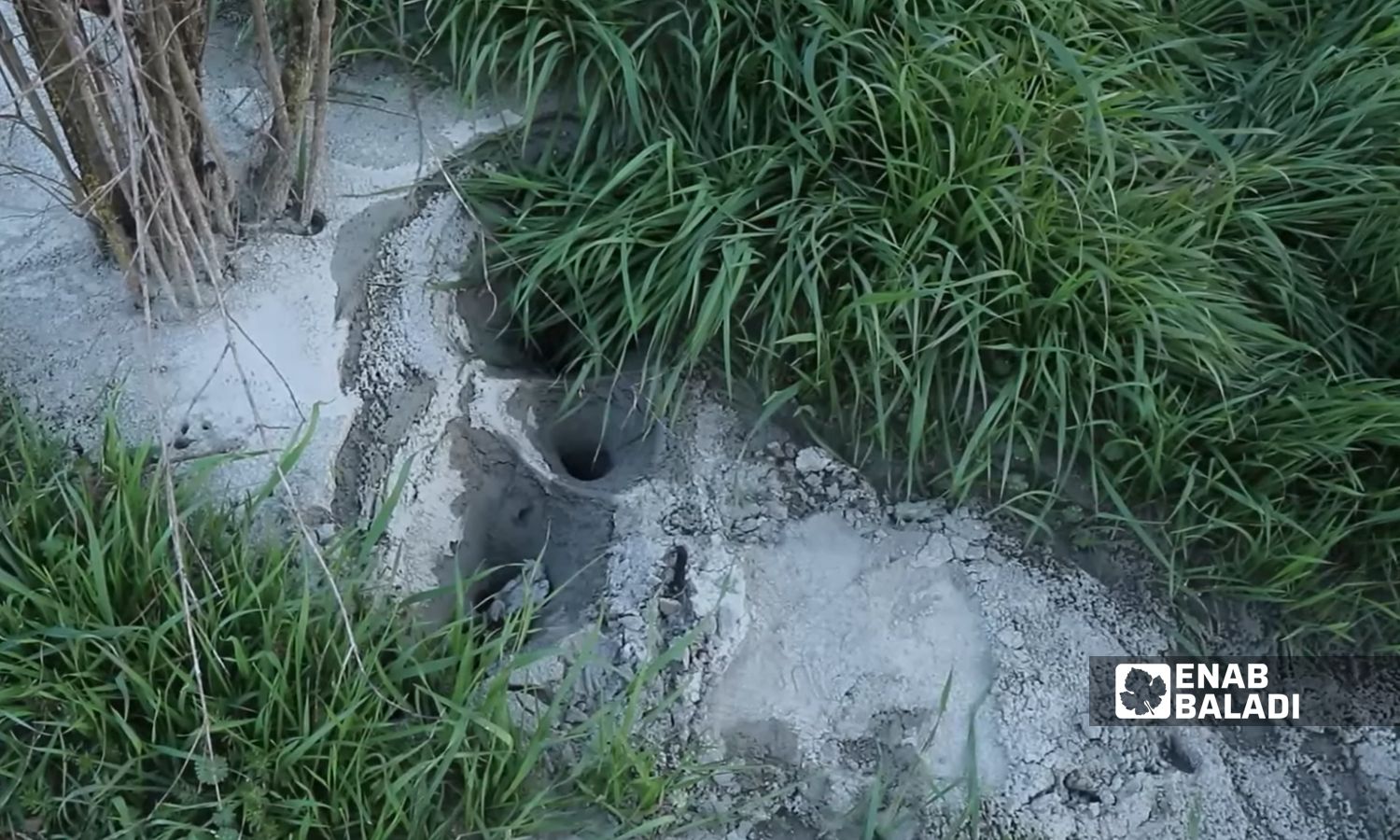



Agricultural lands on both banks of the Orontes (Asi) River, northwest of Syria, were subjected to soil collapses and cracks that created gaps of different sizes, in addition to sand emissions from the ground.
The soil was displaced in separate agricultural lands in the town of Darkush in the western countryside of Idlib, located on both banks of the river, and cracks appeared in the lands adjacent to the river, two to three meters wide and three to four meters deep.
Farmers from Darkush told Enab Baladi that the cracks showed new tunnels in the form of watercourses, and black sand came out of the ground in the form of volcano-like bubbles.
The changes came as a result of the earthquake that struck southern Turkey and four Syrian governorates on February 6.
The farmers attributed the soil displacement towards the Orontes and the cracks that occurred to the fact that the earthquake affected the soil, being fragile and incoherent, and the lands were saturated with river and rainwater.
Geophysicist Ali al-Shaher explained to Enab Baladi that the cracks that occurred on the outskirts of the Orontes River are called local faults, and they are parallel to the course of the river.
These earthquake-related phenomena are represented by subsidence and displacement of the soil with sand emissions in some places, pointing out that these emissions only occur in the case of very severe earthquakes, according to al-Shaher.
The 7.7 magnitude earthquake and its aftershocks, including a major one nine hours after the initial temblor, struck southeastern Turkey and northern Syria on February 6, reducing huge swaths of towns and cities to fragments of concrete and twisted metal. The death toll has surpassed 48,000.

Seismic faults and displacement of agricultural lands towards the Orontes (Asi) River in Darkush in the western countryside of Idlib, as a result of the earthquake that struck the area – February 17, 2023 (Enab Baladi/Mohammad Nasan Dabel)
Soil cracks that are characterized by different mechanical properties may occur due to geological processes of internal forces represented by the physical and chemical properties of the soil or external forces that are natural and anthropogenic factors.
Researchers Jiaping Yan, Xiaoyang Chen, Yi Cai, Fangkui Cheng, and Tingyu Fan divided the cracks resulting from geological processes according to an article titled “A review of genetic classification and characteristics of soil cracks,” published in the journal “Open Geosciences” in 2021 into :
– Cracks caused by natural and man-made earthquakes
The crack length scale is overall large. The cracks distributed in the area affected by seismic activity are mainly extrusion cracks, tension cracks, or shear cracks. The crack scale varies greatly. The cracks in different sizes exist simultaneously in the same location. The crack evolution cycle is short. The crack surfaces are generally straight and regular.
– Cracks caused by hydrogeological processes
The length of cracks is from several centimeters to several meters. The crack distribution direction is consistent with the movement direction of groundwater. These cracks can be divided into two kinds: one is caused by corrosion, and the other is caused by dissolution.
– Cracks caused by landslide effects
The crack length scale varies greatly. The cracks distributed in the landslide body and edge zone have different mechanical properties of extrusion, tension, or shear. The direction of the crack extension may be parallel, vertical, or oblique to the landslide slip direction.
– Cracks caused by karst collapse
The crack lengths are different in size. The cracks are circularly distributed around the central point of the collapse.
– Cracks caused by ground fracture
The length of cracks is from hundreds of meters to thousands of meters. The cracks are distributed in the active area of ground stress. The cracks are characterized by large scale, deep depth, and long extension. Additionally, the crack evolution cycle is long.

Sand emissions in the agricultural lands towards the Orontes River in the town of Darkush in the western countryside of Idlib, as a result of the earthquake that struck the area – February 17, 2023 (Enab Baladi/Mohammad Nasan Dabel)
Science Direct, the website which specializes in publishing scientific and medical information, defines mud volcanoes as cone-like structures that form when mud, a slurry of sediment with water and gas, is extruded at the seafloor.
The website stated that external forces, such as seismic activity along active fault zones, may trigger eruptions and that most mud volcanoes stand only a few centimeters to several meters high.
Mud volcanoes are thought to be deposited due to the overpressure of mud at depth. These over-pressured muds inject through weaknesses of fractures or fissures to the surface.
They are deposited as a mix of mud, fluids, and gases and are usually initiated due to the heating of the subsurface mud. e.g., initiated through heating due to burial. These muds can be brought to the surface by earthquakes or by human activity (e.g., drilling).

An aerial view of a sinkhole in Karapınar district in southern Konya state with a diameter of 37 meters and a depth of 12 meters – February 25, 2023 (Anadolu Agency)
Some Turkish cities witnessed “mysterious” natural phenomena after the earthquake, including a giant sinkhole in the southern Karapınar district with a diameter of 37 meters and a depth of 12 meters in southern Konya province.
Professor Dr. Fetullah Arik of Konya Technical University stated to Anadolu Agency that the new sinkhole is not related to the earthquake that occurred in Turkey early last month.
“We cannot link this sinkhole to the earthquake that occurred on February 6. This sinkhole has nothing to do with the previous big earthquake or the current one,” he added to the AA.
Arik added that it was very difficult to say if it was related to the earthquake because the hole occurred 20 days after the earthquake occurred.
“Residents in the area report that sinkholes like this are common in Karapınar and that large holes have now formed in their neighboring fields. Authorities have advised the public to avoid the site until further notice, as sinkholes can pose a serious risk to individuals and their property,” Arik said.
Aerial images showed that the earthquake caused a large crack, resulting in two huge cracks in the surface of the earth, the longest of which extends about 300 kilometers across southern Turkey, and the divisions appeared across fields and roads, which led to the movement of buildings by meters in either direction.
if you think the article contain wrong information or you have additional details Send Correction